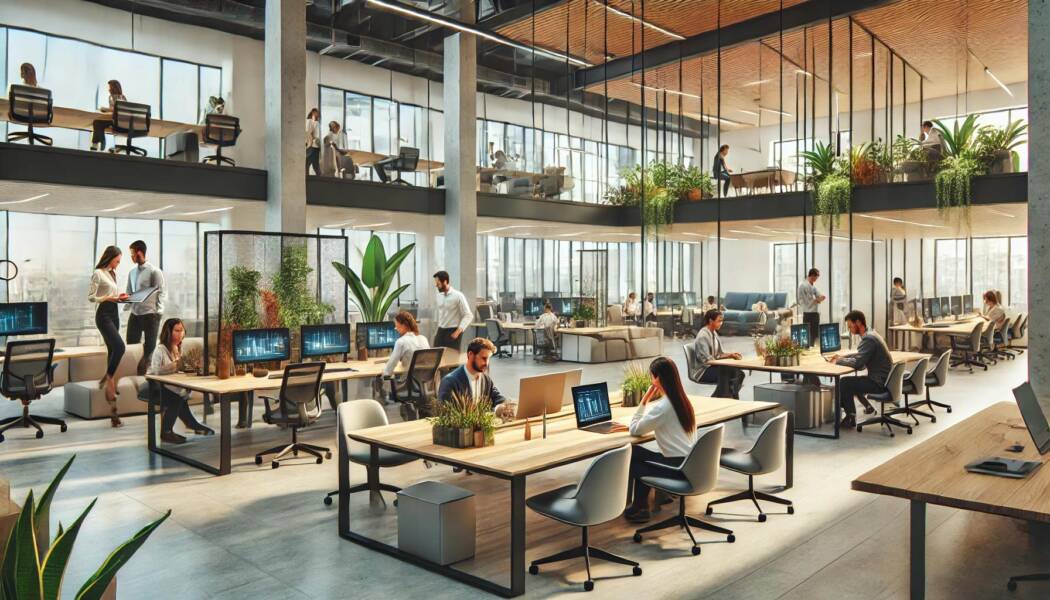In the rapidly evolving landscape of work environments, creating a modern office is essential for fostering productivity, collaboration, and employee satisfaction. A well-designed office can inspire creativity, streamline workflow, and reflect a company’s culture and values. This article explores the essential elements needed to transform your workspace into a modern office that meets the demands of today’s workforce.
Embrace Open Space Design
One of the hallmarks of a modern office is the open space design, which encourages collaboration and communication among employees. Unlike traditional offices with enclosed cubicles and private offices, an open space design creates a more dynamic and interactive environment.
Benefits of Open Space Design
- Enhanced Collaboration: Open spaces facilitate easier communication and teamwork, allowing employees to collaborate more freely and efficiently.
- Flexibility: An open layout can be easily reconfigured to accommodate different team sizes and project requirements.
- Natural Light: Removing walls and barriers allows natural light to penetrate deeper into the office, creating a brighter and more inviting workspace.
- Cost-Effective: Open space designs can be more cost-effective to build and maintain compared to traditional office layouts.
Implementing Open Space Design
To successfully implement an open space design, consider the following tips:
- Use Modular Furniture: Invest in modular furniture that can be easily moved and reconfigured to suit changing needs.
- Create Zones: Designate specific areas for different activities, such as collaboration zones, quiet zones, and relaxation areas.
- Incorporate Greenery: Add plants and green walls to create a more inviting and healthy environment.
- Provide Privacy Options: Include options for privacy, such as phone booths or quiet rooms, to accommodate different work styles and tasks.
Integrate Technology Seamlessly
In a modern office, technology plays a crucial role in enhancing productivity and connectivity. Integrating technology seamlessly into the workspace is essential for creating an efficient and future-ready office.
Essential Technology for a Modern Office
- High-Speed Internet: Reliable and fast internet connectivity is the backbone of any modern office. Ensure your office has robust Wi-Fi coverage and high-speed internet access.
- Smart Meeting Rooms: Equip meeting rooms with smart technology, such as video conferencing systems, interactive whiteboards, and wireless presentation tools.
- Cloud-Based Solutions: Utilize cloud-based software and storage solutions to enable easy access to documents and collaboration tools from anywhere.
- Automated Systems: Implement automated systems for lighting, climate control, and security to create a more efficient and comfortable environment.
Enhancing Office Security with Technology
Incorporating advanced security technology is also crucial for a modern office. Installing vape detectors, for example, can help ensure a smoke-free environment and improve air quality. These detectors can alert management to any vaping activities, maintaining a healthy workspace for all employees.
Foster a Flexible Work Environment
Flexibility is a key component of a modern office. Offering flexible work arrangements and spaces can help accommodate diverse work styles and improve employee satisfaction.
Flexible Work Arrangements
- Remote Work Options: Allow employees to work remotely, either full-time or part-time, to provide greater flexibility and work-life balance.
- Flexible Hours: Implement flexible working hours, giving employees the autonomy to choose their start and end times.
- Hot Desking: Introduce hot desking, where employees do not have assigned desks but can choose any available workstation, promoting flexibility and efficient use of space.
Designing a Flexible Workspace
To create a flexible workspace, consider incorporating the following elements:
- Multi-Functional Spaces: Design spaces that can serve multiple purposes, such as a lounge area that doubles as a collaborative workspace.
- Adjustable Furniture: Invest in adjustable furniture, such as sit-stand desks and ergonomic chairs, to accommodate different preferences and tasks.
- Breakout Areas: Create breakout areas where employees can relax, socialize, or hold informal meetings.
Prioritize Employee Well-Being
A modern office should prioritize employee well-being, as it directly impacts productivity, job satisfaction, and overall health. Designing a workspace that supports physical, mental, and emotional well-being is essential for a thriving workplace.
Supporting Physical Well-Being
- Ergonomic Furniture: Provide ergonomic furniture that supports proper posture and reduces the risk of musculoskeletal issues.
- Active Workstations: Incorporate active workstations, such as treadmill desks or balance ball chairs, to encourage movement throughout the day.
- Wellness Programs: Offer wellness programs, such as on-site fitness classes, meditation sessions, or access to a gym.
Enhancing Mental and Emotional Well-Being
- Quiet Spaces: Designate quiet spaces where employees can take a break, meditate, or focus on deep work without distractions.
- Natural Elements: Incorporate natural elements, such as plants, water features, and natural light, to create a calming and restorative environment.
- Employee Support: Provide resources for mental health support, such as access to counseling services or stress management workshops.
Incorporate Modern Design Elements
The aesthetic appeal of an office can significantly impact employee mood and productivity. Incorporating modern design elements can create a visually appealing and inspiring workspace.
Modern Design Tips
- Minimalist Aesthetics: Embrace minimalist design principles, with clean lines, uncluttered spaces, and a neutral color palette.
- Bold Accents: Add bold accents, such as colorful artwork or statement furniture pieces, to create visual interest and personality.
- Sustainable Materials: Use sustainable and eco-friendly materials in office design, such as reclaimed wood, recycled metal, and low-VOC paints.
- Smart Lighting: Implement smart lighting solutions that adjust based on natural light levels and occupancy, enhancing both aesthetics and energy efficiency.
Promote a Collaborative Culture
A modern office should promote a collaborative culture where employees feel encouraged to share ideas, work together, and innovate. Creating spaces and opportunities for collaboration is key to fostering a connected and motivated team.
Strategies to Promote Collaboration
- Open Communication: Encourage open communication through regular team meetings, feedback sessions, and collaborative platforms.
- Shared Spaces: Designate shared spaces, such as large communal tables or lounge areas, where employees can easily interact and collaborate.
- Team-Building Activities: Organize team-building activities and events to strengthen relationships and foster a sense of community.
Incorporating Practical Workwear
Promoting a collaborative and inclusive culture also involves considering the practical needs of all employees. For instance, providing tactical pants for women as part of a uniform can ensure that female employees have access to functional and comfortable workwear, particularly in industries that require durable and versatile clothing. This consideration reflects a commitment to inclusivity and practicality in the workplace.
Conclusion
Creating a modern office requires a thoughtful approach that integrates design, technology, flexibility, and well-being. By embracing open space design, integrating advanced technology, fostering flexibility, prioritizing employee well-being, incorporating modern design elements, and promoting a collaborative culture, you can create a workspace that not only meets the demands of today’s workforce but also inspires and empowers your team. Whether you are updating an existing office or designing a new one, these essential elements will help you create a modern office that drives success and satisfaction.

Ingrid Maldine is a business writer, editor and management consultant with extensive experience writing and consulting for both start-ups and long established companies. She has ten years management and leadership experience gained at BSkyB in London and Viva Travel Guides in Quito, Ecuador, giving her a depth of insight into innovation in international business. With an MBA from the University of Hull and many years of experience running her own business consultancy, Ingrid’s background allows her to connect with a diverse range of clients, including cutting edge technology and web-based start-ups but also multinationals in need of assistance. Ingrid has played a defining role in shaping organizational strategy for a wide range of different organizations, including for-profit, NGOs and charities. Ingrid has also served on the Board of Directors for the South American Explorers Club in Quito, Ecuador.







